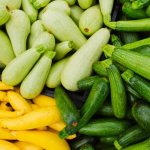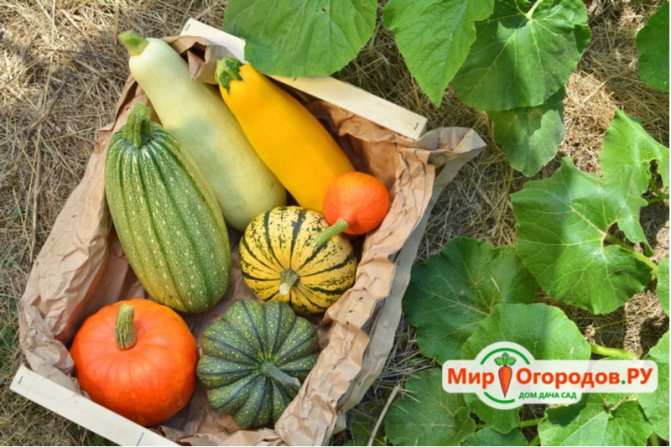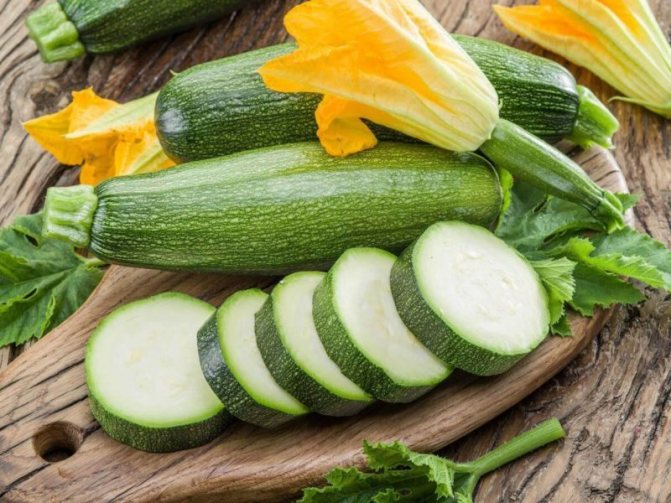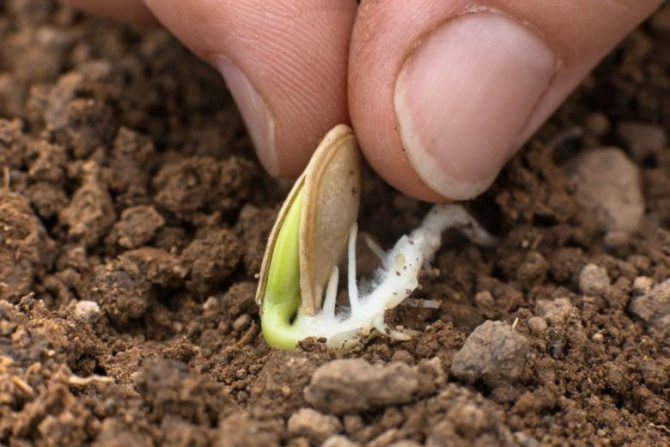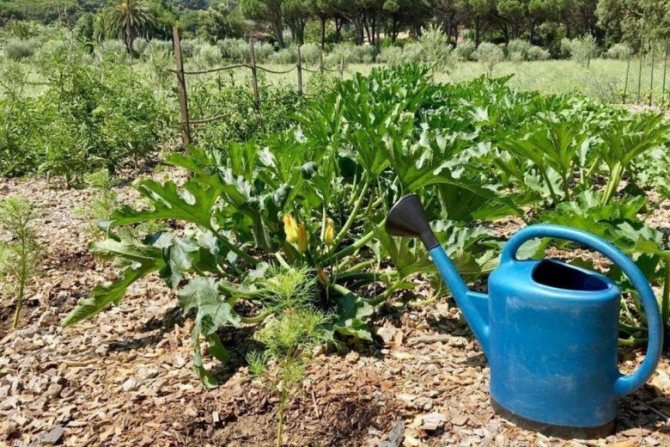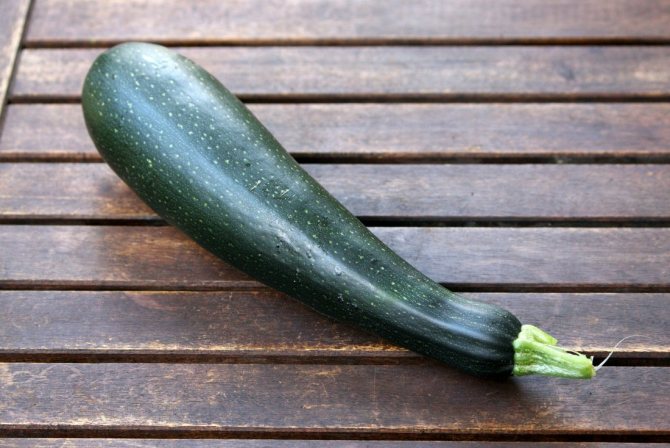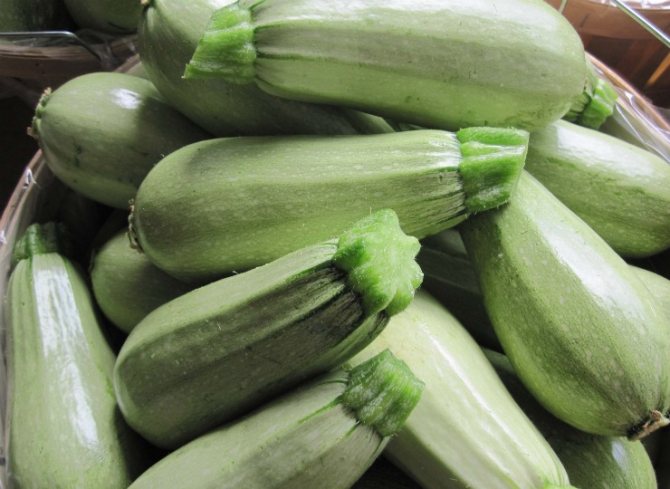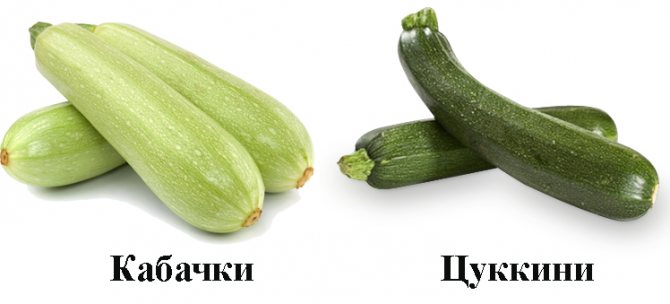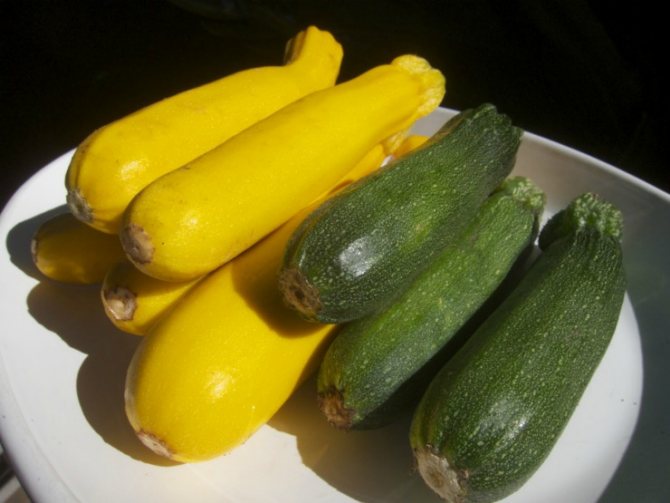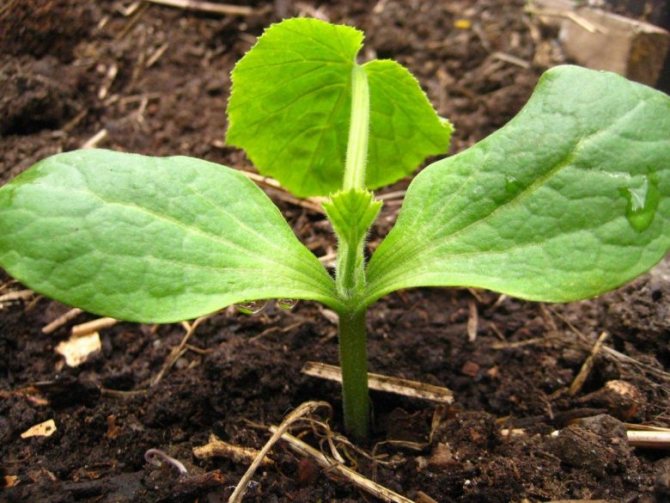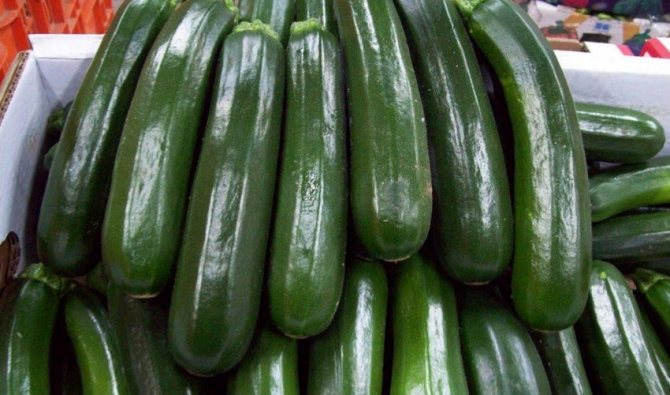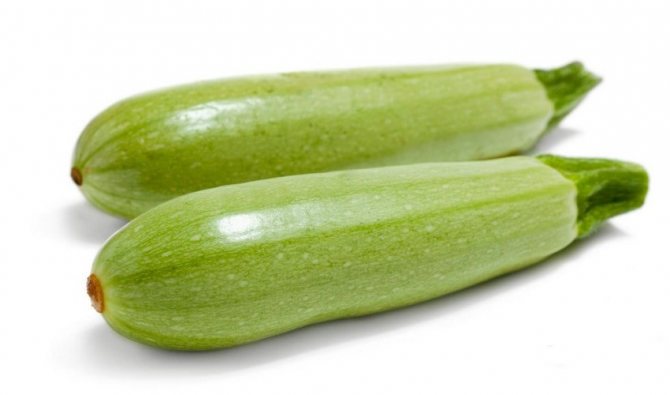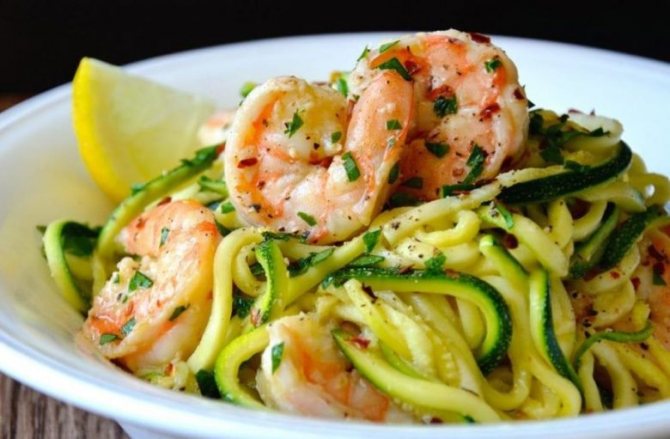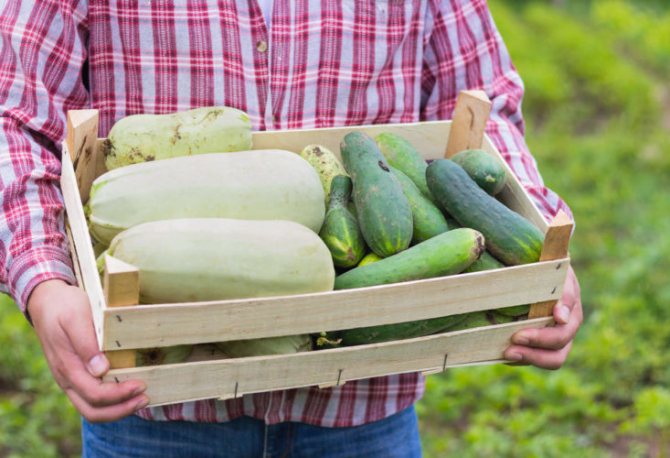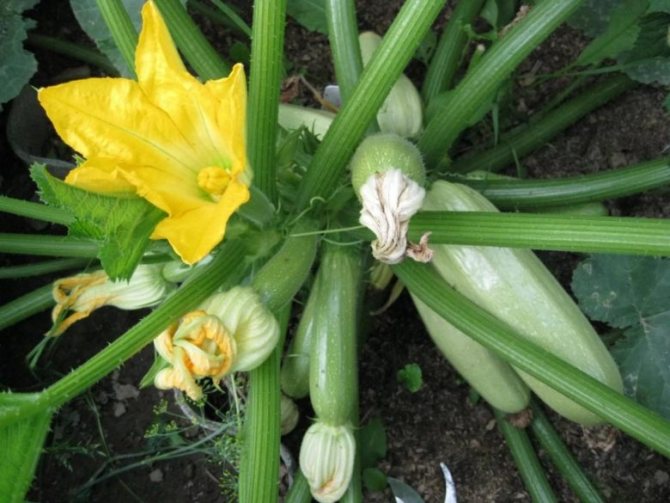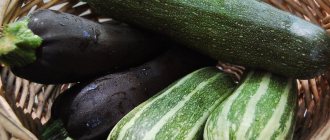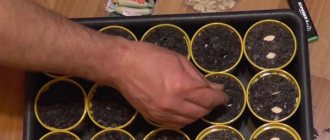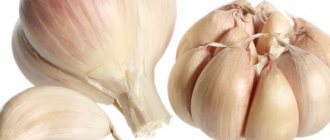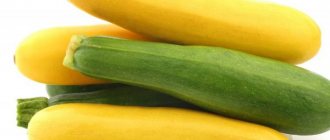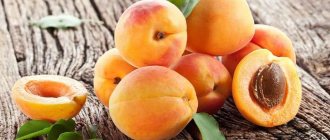Zucchini and zucchini are a bushy variety of common pumpkin, and pattison is adjacent to them. The name "zucchini" has Turkic roots, and "zucchini" comes from the Italian zuccawhich means "pumpkin". In Russian, the borrowed Italian word zucchini (read as "zucchini") has become a zucchini with one letter "k". Despite the close relationship of these vegetables, there are some differences between them.
White-fruited zucchini, green and yellow zucchini
Zucchini - what is it?
Zucchini is a type of zucchini, belongs to the pumpkin family... This plant, like a squash, forms a bush, but more compact - it reaches a height of up to 120 cm. Its small branching makes it possible to productively use the garden plot. The leaves of the shrub are large, with a diameter of 25 cm and more, not thorny, with slight pubescence, cut along the edges. They often have an ornament in the form of stripes and streaks.
The zucchini fruit is small in size, its maximum length is 25 cm. The shape of the fruit can vary from cylindrical, oblong (as, for example, in the white-fruited zucchini) to spherical. The peel has the most varied colors: black, dark green, gray-blue, variegated, striped.
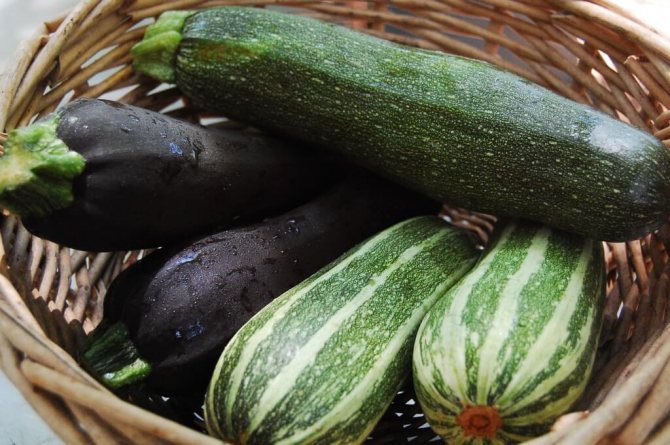
Small seeds are present in the pulp, but they are so invisible that the fruit is eaten whole. This vegetable is characterized by a high yield: up to 20 fruits from one bush.
Interesting fact! In England, Bernard Lavery grew the largest zucchini fruit - its weight was 65 kg.
The advantage of the vegetable is early ripening, because its fruits can be eaten within 5-7 days after the ovaries appear... It is noteworthy that zucchini does not need to be heat treated, unlike classic zucchini, because they taste good even raw and can be served as a summer snack. This vegetable can be used to prepare various dishes: stews, pasta, cream soup, casseroles.
Good to know! In the plant, not only fruits are edible, but also flowers. In Italy, they are stuffed with bacon and baked, and zucchini can also be added to pies along with soft cheese.
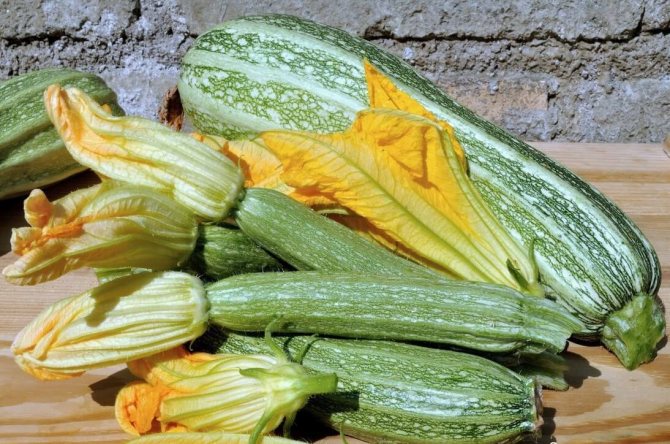

Anyone who first encountered such a new concept as zucchini thinks about how to spell the given word correctly: zucchini or zucchini. Let's try to figure it out.
The spelling confusion is due to the fact that the word is of Italian origin, and in Italian it is spelled zucchini and pronounced "zucchini". On the Internet, you can find another Russian variation of this word: "zucchinni", but this is an absolutely wrong spelling. Despite the fact that because of the spelling of the Italian word, many people in Russian write the name of the vegetable with two "k", in the spelling dictionary, its correct spelling is clearly recorded - "zucchini", that is, with one letter "k".
Zucchini and zucchini - what's the difference?
The difference between zucchini and zucchini is described below:
- Primarily, color. The zucchini rind is yellow or lighter, white. The peel of zucchini most often has a green color, sometimes vegetables with black, yellow, striped peel color are found.
- The size. In zucchini, the fruit is capable of reaching large sizes. In zucchini, on the other hand, the fruits are quite small.In most cases, they are picked when they reach 15 centimeters in length - in this state, they are tastier.
- Taste. Zucchini has a fairly dense pulp, they are well suited for frying and boiling. Zucchini, on the other hand, has a softer and more tender flesh that can be eaten raw, as a snack or in salads.
- Peeled. Zucchini has a soft and tasty skin, which is suitable for food, so you can not cut it off from a vegetable, especially since it is rich in vitamin C. When cooking zucchini, for the most part, its skin is cut off, since it is quite tough.
- Seeds. Zucchini pulp is rich in seeds, therefore, due to their huge amount, the seeds are removed from the fruit. The seeds of zucchini are so small that they are almost imperceptible, for this reason the fruit is prepared whole.
- Features of cultivation. Zucchini ripens much faster than zucchini, but the latter needs more light and heat. If frosts come (the temperature drops below +5 degrees), the plant dies. But the variety of zucchini bears fruit perfectly without interruption (if the temperature conditions are observed), which makes it more significant in agriculture.
- Storage. Zucchini can be perfectly preserved for quite a long time (it will not lose its appearance and will not lose its useful properties until next year). But zucchini is recommended to be eaten as soon as possible.
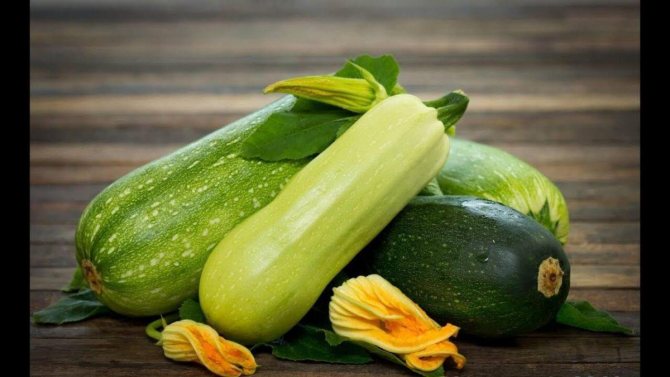

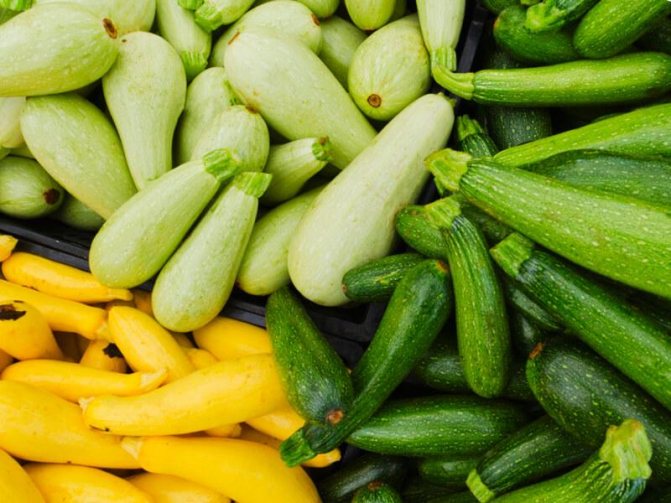

Some similarities between the two vegetables:
- Low calorie content. Both vegetables have a low calorie content: in zucchini - 27 Kcal, and in zucchini - less than 16 Kcal. Thus, they are great for dieters.
- The presence of large amounts of vitamin C, potassium, carotene and folic acid.
- Good digestibility by the body. Due to this feature, these cultures are recommended by pediatricians for use with the first feeding of babies.
- Improving digestion and removing harmful substances from the body. For this reason, doctors advise using these vegetables for diseases of the kidneys, liver, stomach and heart.
- Ease and speed in preparation.
Origin
The birthplace of zucchini is considered to be Mexico, from where they came to Europe in the 16th century. At that time, the nutritional and taste properties of these fruits were not yet appreciated. Only seeds were eaten (as in other pumpkin species).
The Italians were the first to guess to taste the pulp of an unripe zucchini, after which they gladly included it in the list of culinary products.
They also soon bred a new variety of pumpkin vegetable, crossing an ordinary squash with kruknek pumpkin. This is how the first zucchini appeared. From zucchini, they adopted the appearance, and from the crookneks - taste and nutritional properties. Both vegetables arrived in Russia only in the 19th century.
Types and varieties
Today there are a huge variety of zucchini varieties (you can see some of them in the photo), which are usually classified by ripening time.
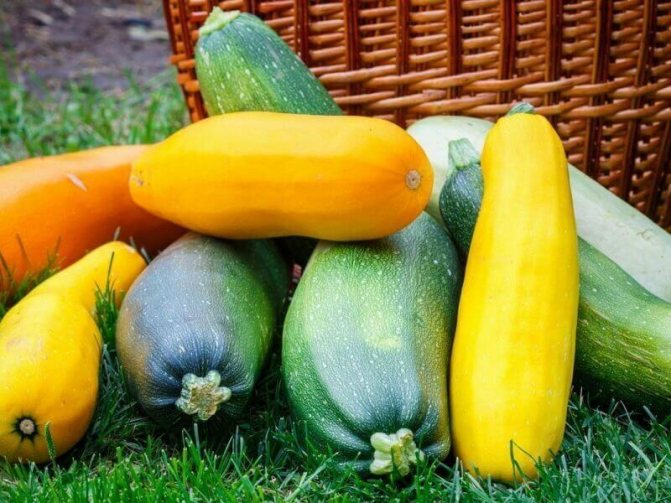

Early ripe
Such varieties allow you to get a harvest already 37-45 days after the appearance of the first shoots, which makes them indispensable for residents of colder regions.
- Aeronaut. This variety is capable of bearing fruit after 45 days. It grows as a dense bush. The fruit has a cylindrical shape, weighing up to 1.3 kg, has a smooth skin of light green color and whitish-yellow flesh. The peel also has an ornament consisting of small dots. The variety is quite picky about care: it brings a bountiful harvest only on nutritious and fertile soil, and provided that watering is plentiful and regular. If you do not follow the rules of care and maintenance, the plant will become susceptible to diseases such as powdery mildew.
- Zebra. The vegetable received this name for the peculiarity of its color - the peel is covered with dark stripes.The bush of this variety is low-growing. The crop can be harvested after 38 days. The shrub can yield up to 9 kg of yield. Zebra fruits weighing about 900 grams, have a cylindrical shape, are colored light green, covered with dark stripes. The pulp has a whitish-yellow color, rather juicy, slightly sweet. This variety is resistant to cold weather - it can grow even when the temperature begins to drop significantly, for this ability it is recommended to plant it outdoors. Stores well and tolerates transportation remarkably. It is usually used as a snack and when preserved.
- Negro child. The fruits ripen in about 40 days. It grows in the form of a shrub, well adapted for growing without any shelter. The fruit has a cylindrical shape, its weight reaches 400-900 grams, covered with a dark green skin with small specks. The pulp is tasty, very juicy, contains 2.4% sugar. From a bush of this variety, you can harvest up to 10 kg. Just like the previous variety, has good cold resistance. It can be used in any kind of culinary treatment.
- Diamond. It is characterized by excellent endurance - the variety is able to tolerate both drought and abundance of moisture equally well. Begins to bear fruit 40 days after the appearance of the first shoots, about 20 kg of yield comes out from one bush. The fruit weighs 600-900 grams, reaches up to 22 cm in length. It has a cylindrical, slightly curved shape, dark green skin, covered with frequent stripes and contains white flesh. The variety perfectly tolerates transportation and is able to be stored for a long time. This variety can be eaten both raw and fried, stewed.
- Pharaoh. This variety ripens in about 40 days and has a high yield. The fruits are elongated, have a dark green color, light specks, have a delicate, thin skin and yellow sweet pulp. The weight of the vegetable is about 800 grams. The plant is capable of bearing fruit for a long time, from the last days of June to the last days of August. The variety is quite resistant to gray rot.
- Oilman's breakfast. This variety has a good yield. The bush is compact enough to make the harvesting process easier. The fruits have a dark green color, cylindrical shape, delicate tasty pulp, can reach a length of 25 cm. Vegetables of this variety can be stored for a long time due to their strong fruit skin.
- Black handsome. This variety is characterized by high yield and early maturity. The fruit, weighing about 1.5 kg, has a cylindrical shape, smooth, shiny skin of dark green color, light, dense and juicy pulp. The advantages of this variety are: immunity to powdery mildew at the genetic level, yield stability, excellent keeping quality. A young vegetable (10-15 cm long) of the Black Handsome variety has received recognition for its delicate taste as the most delicate summer snack and an indispensable ingredient in summer salads.
- Salvador F1. The Dutch variety is also in great demand by Russian gardeners. The fruit ripens within 30-35 days, the plant continues to bear fruit for a long time. It grows into a strong bush with a cylindrical shape of the fruit, weighing 300-350 grams. The peel is smooth, shiny, has a dark green color. In extreme heat, the fruit can stretch in length. The increased yield of this variety is due to its natural resistance to viral diseases and powdery mildew. The plant feels great both in greenhouses, under the film, and in the open field. The vegetable has an excellent taste, for this reason it is used for preservation, frying, salting, for barbecue.
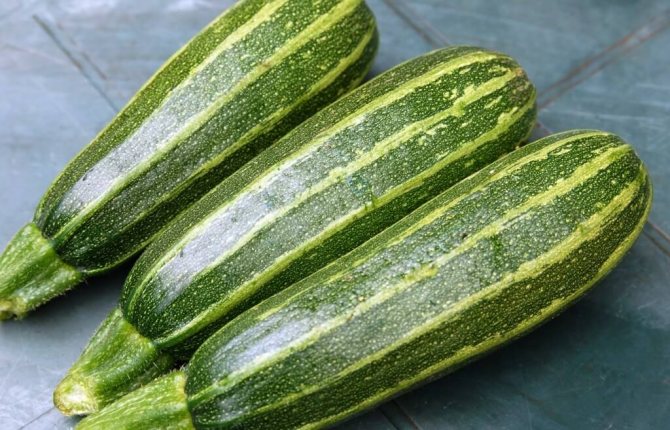

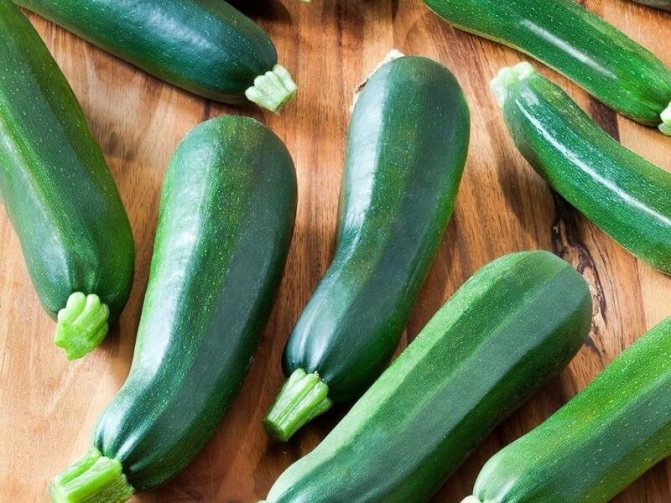

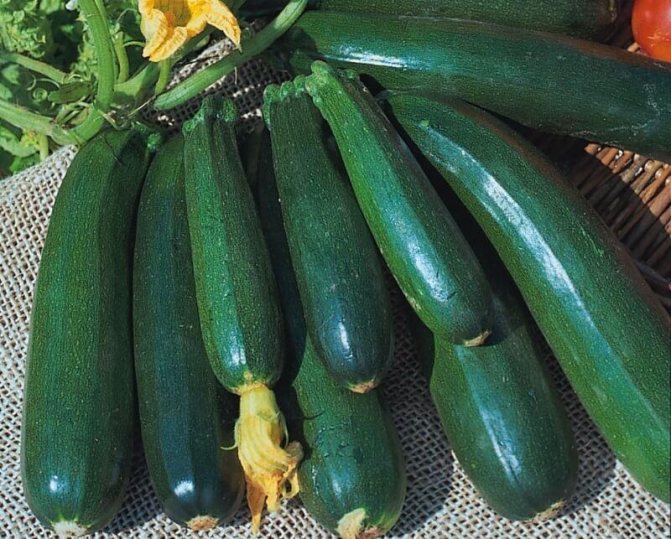

Mid-season varieties
These varieties begin to ripen 45-55 days after the first shoots appear.
- Kuand. Begins to bear fruit on the 52nd day. Up to 23 kg of harvest is harvested from one bush.The fruits are cylindrical in shape, painted in a pale green color, which is dissected by dark stripes and spots. The weight of one fruit is about 1 kg. The vegetable has a juicy, tender white pulp. Differs in good fruiting not only in the open field, but also in the greenhouse. The plant is quite resistant to gray mold infection. This variety is valuable for its tasty fruits and stable yield. Zucchini Kuand, the photo of which you can see below, is used as a snack, and it is also suitable for preservation.
- Zolotinka. A variety of Italian selection, recommended for planting in open areas. One semi-growing bush is capable of producing up to 5.2 kg / m² of yield. Fruits are ribbed, cylindrical in shape, weighing about 1 kg, have a smooth thin skin of a bright yellow color, covered with small specks. Delicate light yellow pulp is used in the manufacture of baby food.
- Ronda. The variety is distinguished by its high yielding capacity and is appreciated for its long-term fruiting. A distinctive feature of this zucchini variety is the shape of the fruit - it is round, somewhat similar to a pumpkin. Fruits are about 8-10 cm in diameter, covered with grayish-green skin and dark spots and stripes. The plant is quite unpretentious, actively developing. Use Ronde for pickling.
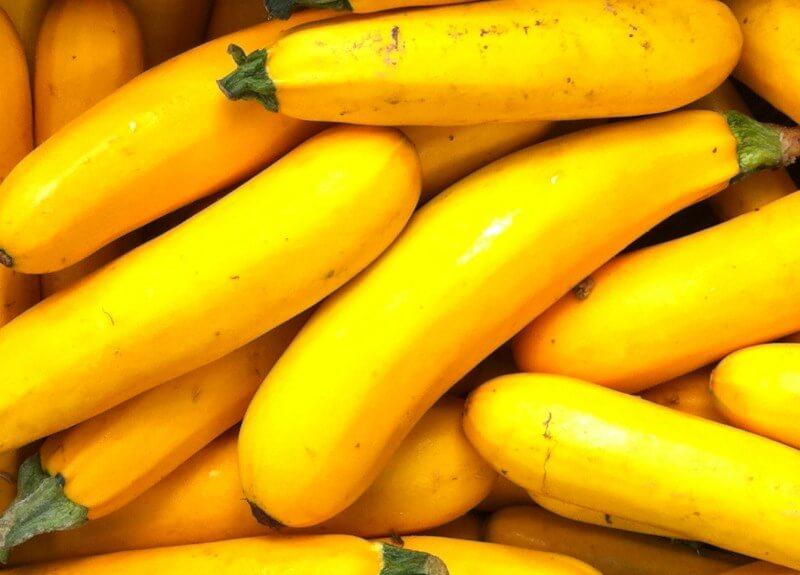

Varieties for open ground
For planting in open areas, it is necessary to choose varieties that can best adapt to different weather conditions. In the photo you can see what the zucchini of these varieties looks like.
- Diamond F1. This variety has good yields and early maturity. In one season, about 20 fruits of an even cylindrical shape, dark green or green in color, about 20 cm long can be harvested from the bush. The pulp is dense, tender, has a pleasant taste, inside there are small and underdeveloped seeds. The plant itself is strong, well resistant to cold weather.
- Helena. This variety is able to bear fruit even at low temperatures. The vegetable itself is elongated, cylindrical in shape, weighing 600-1000 grams, its skin is smooth, dark green in color. The fruit has a light and firm pulp.
- Drakosha. It is an early maturing variety, begins to bear fruit 41 days after germination. The bush has fruits weighing 500-900 grams, cylindrical in shape, with a smooth bright yellow skin. The pulp is yellow and has a pleasant taste.
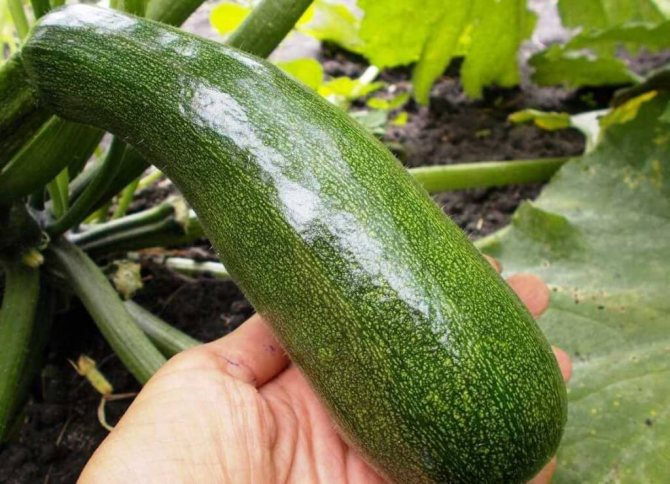

Small zucchini varieties
- Ball grade. This is an early ripe variety, the fruits of which are quite small (weighing up to 500 grams), have a spherical shape, similar to an unripe pumpkin, and are colored striped green. The pulp is white, juicy enough. The most popular in cooking are young fruits, weighing 100-150 grams, which are whole salted, stewed, stuffed with meat or other vegetables.
- Mini zucchini. The variety ripens 45-50 days after the emergence of shoots, has medium-sized (weighing 300-500 grams) cylindrical fruits with a light green color and white spots. Light pulp is juicy, used for preservation and snacks, in diet food.
- Tondo Chiaro. Translated from Italian, the name zucchini means "round light". The plant forms a shrub on which small fruits of a round shape and green color with yellow spots ripen. You can harvest the crop after 45 days. The fruits can be harvested when they reach a length of 10 cm.
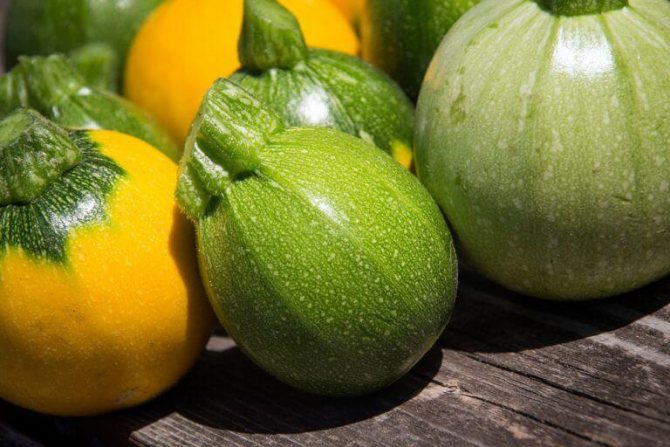

Landing features
There are two planting methods: using seedlings or seeds. The choice of planting option depends on the climate in which you live, as well as on the desired harvest time. If there is no need for a quick harvest of fruits, you can sow zucchini seeds directly into the ground. But before that, you need to prepare the soil: dig small holes at a distance of about 70 cm from each other, then fertilize them with humus or compost, and then you can sow the seeds.After about a month, the plant will bloom.


Seeds should be sown between late May and early June. It is recommended to sow not in extreme heat, but not in cold, for the reason that if the temperature drops below -2 degrees, zucchini may die.
If there is a desire to plant seedlings, then this is done in this way: a mixture of humus and peat is added to special planting containers or pots. Then the substance is lightly watered, the seeds are laid out on it and sprinkled with soil mixture (to get a layer of about 2-3 cm). Water the seedlings every 10 days. During the growth of seedlings, it is necessary to feed the plants twice: when the first shoots appear and 10 days after that. The most commonly used fertilizer is "Bud" or "Agricola".
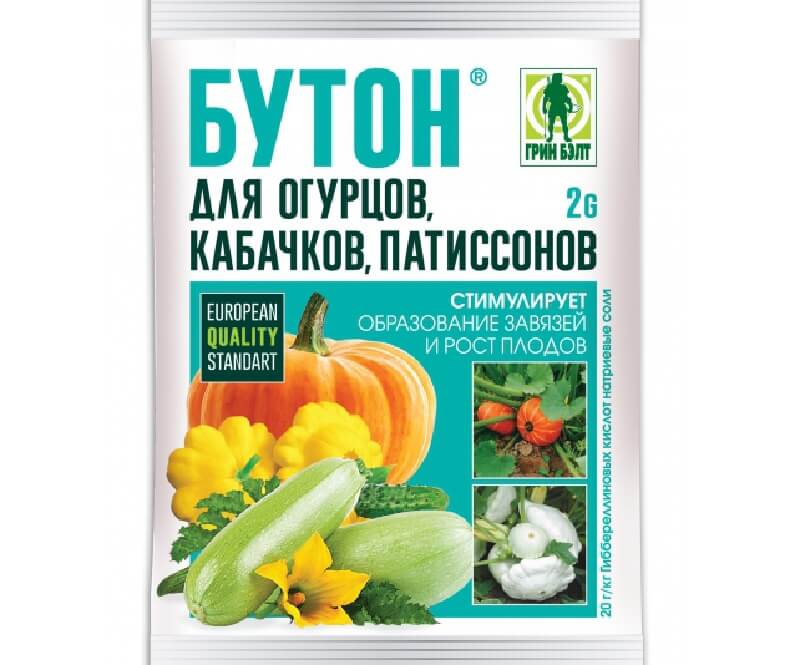

Note! It is necessary to sow zucchini seeds for seedlings 30-35 days before planting them in open ground.
Zucchini leaves
Zucchini leaves are an organ responsible for the processes of gas exchange and photosynthesis, through which respiration and evaporation of moisture occurs. They consist of a petiole and a leaf plate. The shape is five-lobed, the incisions can be small or reach 2/3 of the leaf. What leaves in a squash depends on varietal characteristics. In hybrids, the leaf blade often has white or silvery spots. Basically, the culture has green or dark green leaves of a large size, up to 25 cm.
The petiole reaches a length of 30-35 cm; short, hard hairs grow on it and on the plate. The leaves form a sprawling bush, at the base of which fruits grow. To build up green mass, the use of nitrogen fertilizers, humus and compost is recommended. But feeding should not exceed the established norms. Overgrown leaves impair air exchange, interfere with the heating of fruits and soil. If necessary, some of them can be cut off.
Leaves are the first to react to infection with various fungal and bacterial infections.
Care
Most varieties of zucchini are unpretentious in care and maintenance. However, some points in their cultivation should be known and applied in practice.
Loosening the soil
In order for zucchini to grow well and give a large harvest, soil preparation is important for them. The garden on which the vegetables are planted should always be loose and perfectly let through the water. How often you need to loosen the soil will depend on what kind of soil you have on the site. There are soils (for example, loam) that can harden and form a crust on the surface. This type of soil requires more frequent loosening.
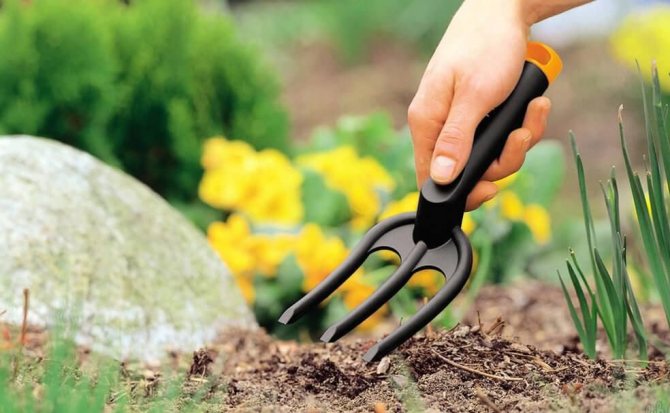

Watering
It is necessary to water this plant regularly, but it is important not to overdo it. For this reason, zucchini is watered every 10 days, but in such a way that about 10 liters of water are used for every 1 m². The temperature regime of the water should not be neglected either. If you water the plant with cold water, the ovary can start to rot. In order not to spoil the fruits, watering must be stopped 10 days before harvesting. This variety of zucchini does not like high humidity, for this reason, if vegetables are grown in a greenhouse, it should be ventilated at regular intervals.
Top dressing
As a top dressing, special fertilizers or mullein infusion are used. Fertilize at least twice: at the time of flowering of the plant and during the ripening of the fruit. Then top dressing will provide high yields.
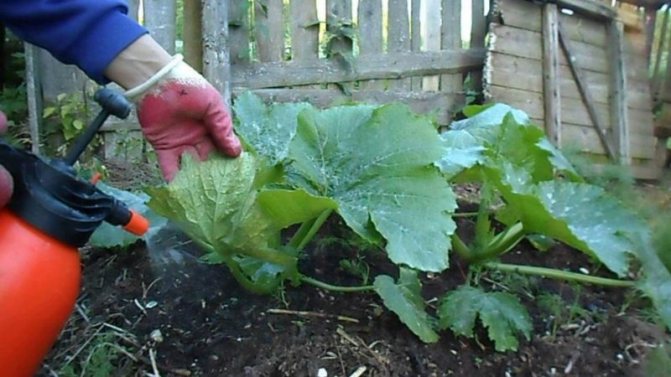

The benefits of zucchini
- For digestion. Zucchini has good digestibility in the body, so it can be included in the diet. Zucchini contains more fiber (the highest concentration of fiber is located in the skin of the vegetable), for this reason, the fruit can be consumed as food to prevent constipation.
- Slimming. The vegetable is low in calories, for example, 100 grams of zucchini has only 20 kcal.Therefore, when drawing up a dietary menu that helps to lose extra pounds, it is recommended to include this type of zucchini in the diet more often. Much of the weight loss process is due to the fact that zucchini helps the body remove excess fluid. Therefore, the fruit can and should also be consumed by people who suffer from edema.
- For the skin. The vegetable contains medicinal properties that help improve the condition of the skin. This is explained by the fact that zucchini contains a huge amount of vitamins, such as: vitamin A, C and some B vitamins. Thanks to these substances, the skin receives sufficient nutrition and becomes elastic and elastic. At the same time, they improve their condition and nails.
- For heart. The benefits of zucchini for the cardiovascular system are explained by the potassium content inside the fetus. Since potassium is one of the most important micronutrients for heart function, zucchini is recommended for people who have heart problems or to prevent them.
- During pregnancy. As you know, during pregnancy, a woman needs an increased amount of nutrients, one of which is folic acid, which can prevent serious problems in the development of the embryo. Since there is some acid in the fruits of zucchini, the vegetable is recommended for pregnant women.
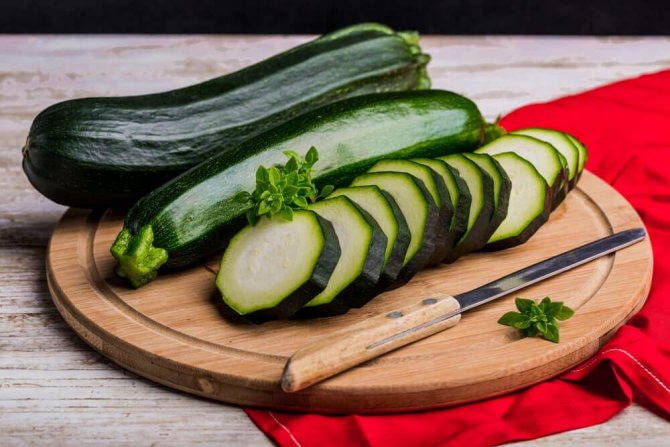

Also, the vegetable will bring significant benefits to people with liver disease, because the fruit helps proteins assimilate in the body. The fruit is also useful for small children.
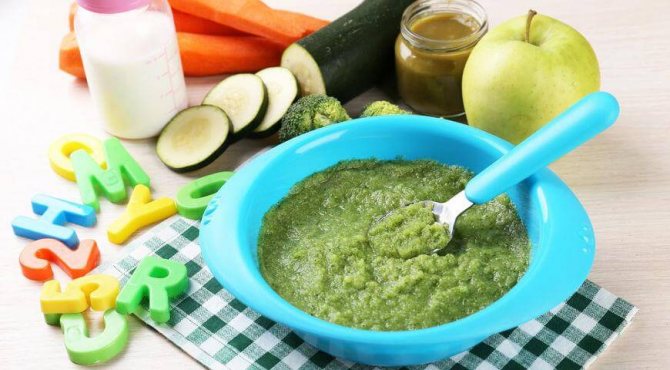

Good to know! For medicinal purposes, not only the zucchini fruit is used, but also its flowers, a decoction of which helps to alleviate the course of allergic diseases.
Similar articles:
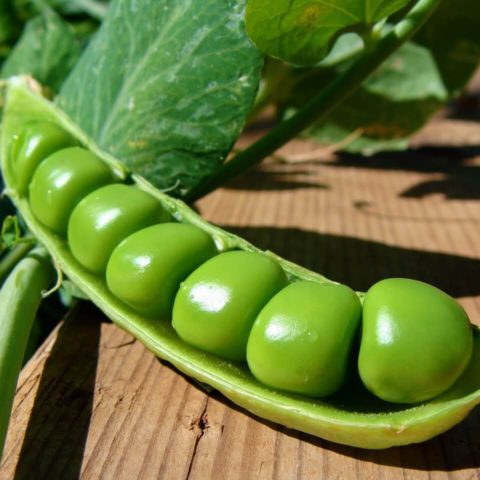

What are peas? Description, types and varieties, features ...
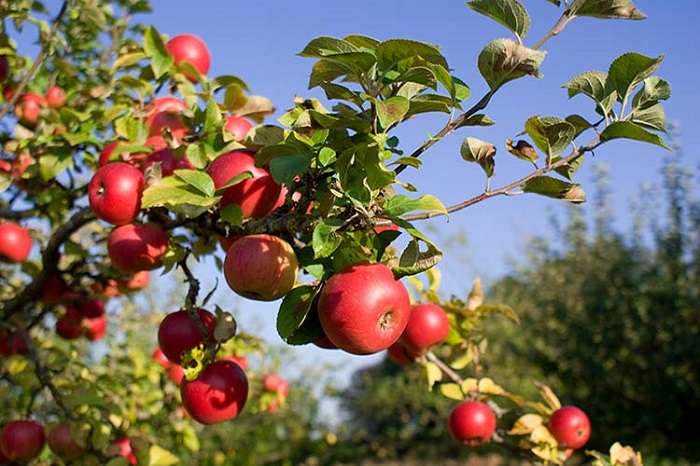

What is lichen and how to get rid of it on an apple tree?
What is nitrogen fertilization and what is their effect on the soil?
Beneficial features
Both products contain the following minerals necessary for humans:
- phosphorus, calcium and iron, which have a positive effect on the condition of bone tissue;
- folic acid - essential for the normal functioning of the intestines;
- magnesium improves the functioning of the circulatory system and heart.
Among the vitamins, the following should be noted:
- vitamin C, which has a positive effect on the human immune system;
- vitamin B, which helps to improve memory;
- PP vitamins, which improve brain function.
Zucchini and zucchini contain fiber, which is essential for the normalization of metabolism.

